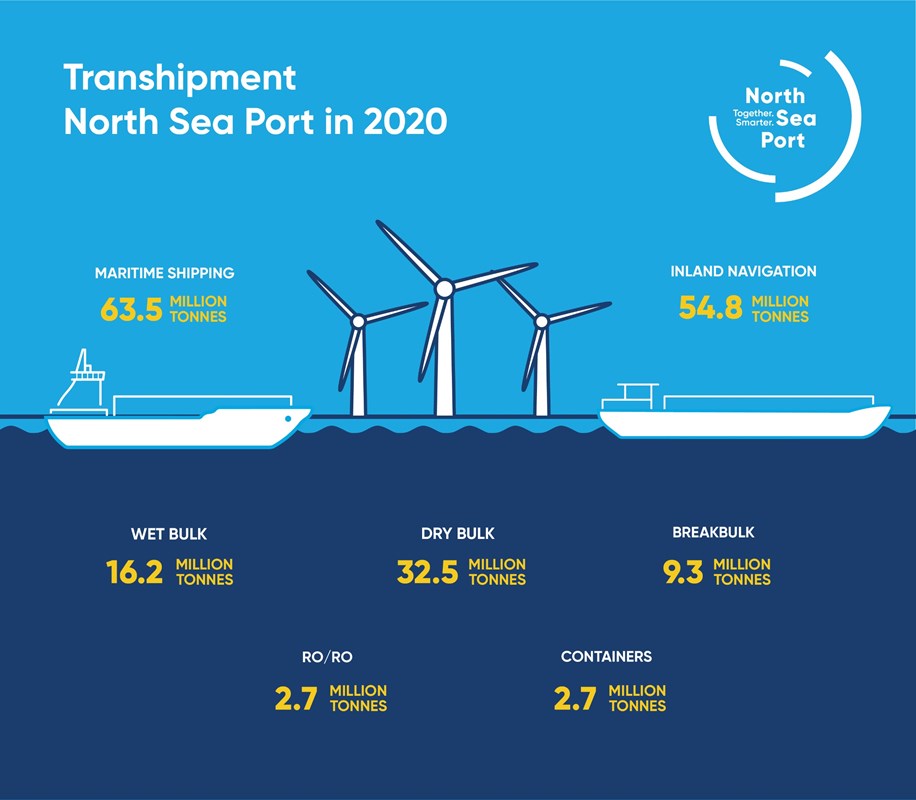In 2020, the companies in North Sea Port reported 63.5t million of cargo transhipment from maritime shipping, a decrease of 11.2%. The coronavirus crisis, Brexit and the oil crisis clearly made themselves felt. The transhipment of containers continued to grow, while 2020 was a record year in terms of land allocation.The Dutch-Flemish port recorded 8t million less maritime cargo transhipment than the year before. Of the total, 70.5% were import and 29.5% export.
North Sea Port has seen steady growth over the past decade and, starting in 2017, posted three record years in a row. With 63.5t million of cargo transhipped in 2020, North Sea Port is back at the level of 2016/2017, i.e. immediately before those record years. However, the 11.2% drop in 2020 is far removed from the year 2009 when, as a result of the financial crisis, almost a fifth of cargo transhipment was lost – 15t million more were posted in 2020 than in this crisis year of 2009.
Container transhipment on the rise
More than half of cargo transhipment via maritime navigation at North Sea Port is dry bulk. This fell by 6% in 2020 to 32.5t million. Dry bulk still managed to hold its own reasonably well in 2020, given that there had been a 10% increase over the two years before. The decline was mainly seen in solid fuels (petcoke, coal and anthracite) and iron ore. One bright spot was the modest increase in the transhipment of blast furnace and iron slag, limestone, scrap metal and wood pellets and wood waste. There was also good news with regard to containers. This segment had already doubled in volume in the years 2018 and 2019. 2020 again saw growth: transhipment increased by 4.3% to 2.7t million. In 2020, more containers were shipped to Great Britain and a fifth more bananas were transported in containers. At 16.2t million, liquid bulk accounted for one quarter of maritime cargo traffic. However, 2020 saw a decrease of 19.3%, which is entirely accounted for by petroleum products (naphtha mixtures, gas and diesel oil, naphtha and biodiesel). General cargo totalled 9.3t million. This traditionally strong segment saw a decline of 15% in 2020. Half of that was due to cellulose, but there were also falls in rolled steel and some construction goods such as bricks. Ro-ro transport dropped by 16.8% to 2.7t million. This was mainly due to lower production and exports of cars and the temporary closure of a car plant during the first lockdown, lower volumes due to staff leave in the summer and restrictions on imports to the UK. By the end of 2020, the transport of cars to the United Kingdom was back on track.
Main trading partners
The same countries that appeared on the list of North Sea Port’s top five trading partners in 2019 featured again in 2020. Russia remained at number one. The UK finished in second place, leapfrogging the US which moved down to third. Canada rose one place to fourth. Brazil dropped one place to take fifth spot.
Inland navigation
In 2020, North Sea Port recorded 54.8t million of inland navigation transhipment, of which 44% were import and 56% export. That total is 6.3% less than in 2019. With 63.5t million of cargo transhipment from maritime navigation and 54.8t million from inland navigation, North Sea Port posted a total of 118.3t million for cargo transhipment in 2020.
Record for land allocation
2020 was a record year for North Sea Port in terms of land allocated to investors. The total of 76.4 acres of land issued represents a near doubling compared to 2019. The investments by Evolution Terminals for the storage of liquid bulk, a green hydrogen plant for VoltH2 and a large logistics park for Heylen Warehouses stand out for their size in terms of area, budget and job creation.
Recovery expected in 2022
In 2020, maritime cargo transhipment fell by 11.2%, while the decrease in inland navigation was limited to 6.3%. Not all fluctuations in the figures can be explained by the coronavirus, but many were the direct or indirect result of the virus. In addition, Brexit and the petroleum crisis also had an impact on the transhipment figures. Only from August onwards was there a very slight recovery compared to the previous months, after which the differences in November and December were less marked. North Sea Port is looking forward to a more positive 2021, with losses halved by the end of the year provided there is not a severe third lockdown. Over the course of 2022, a full recovery is expected to around 71.5t million, the transhipment volume recorded in 2019. Resilience and recovery among companies in sectors such as automotive, dry and liquid bulk, steel and transport can contribute to this. Moreover, a number of investments already announced will produce results in terms of transhipment figures and employment. North Sea Port is also anticipating a healthy number of new land allocations and new investors in 2021.



